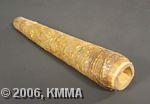

The urusengo is a wooden flute made from a branch of the umusekera or the umusave. It averages 15 cm in length and is conical. To make it easier to hollow out the branch, it is first split lengthwise. The two equal halves are then hollowed out in such a way as to ensure that the basic conical shape is preserved even on the inside. The two conical pieces are then rejoined and secured with twine wound round most of the length of the instrument. A piece of the trachea of a bull (umumiro) is then stretched over the whole flute. The mouthpiece is oval and measures about 22 mm by 25 mm, with a 4 mm opening at the bottom.
The urusengo is mentioned in the oral literature as an important instrument for the first bami (kings). Gihanga is said to have introduced it under the name Nyamiringa. Within this royal tradition the urusengo was played by the abasengo, who, together with the abatware (chiefs), the abiru (ritual specialists) and the abasizi (poets), formed a group that always accompanied the king during his travels. The royal symbols were insengo, ingabe (drum), inyundo (hammer) and umuvuba (flute). The urusengo was used in various rituals, from which it can be inferred that the instrument most probably existed in the eighteenth century. Besides its ritual function, it also had a role in the everyday life of the court, where it was only played in the presence of the king.
The urusengo probably comes from Uganda originally, where a similar instrument is found in several kingdoms (Nyoro, Toro, Nkore and Ziba). This seems logical enough when you consider that geographical boundaries have often shifted over the course of history and consequently there have been different cultural influences. Now that Rwanda is a republic, the urusengo has lost its royal status. Traditional compositions still exist, but are only performed at festivities and special events organised by the government.
Before playing the urusengo, the musician pours a little banana beer into the instrument, which is said to produce a gentle, clear sound. This is a fairly common custom in Africa among flute players. The instrument is side-blown and can produce two different notes by covering the opening at the bottom. The urusengo is always played as part of an ensemble of at least five insengo, never alone. Within the ensemble three types can be identified, depending on the pitch: the ishakwe (high), the inyahura (medium) and the ibihumirizo (low). There is always just one ishakwe, which is played by the leader of the ensemble, but several of the other two types. The musical accompaniment provided by the inyahura and the ibihumirizo, which are always played together, consists of rhythmic alternation between one or two chords, while the high-pitched ishakwe plays a variation on this basic theme in terms of rhythm and pitch (although it, too, can only play two notes). The instrumental ensemble backs a choir and the singers add to the rhythmic beat by clapping their hands.
For more information consult the following publications edited by the RMCA:
© KMMA/Jos GANSEMANS